Last December, Porsche CEO Oliver Blume said the new 911 Dakar might not be a one-off, but rather the first of several off-road sports cars. After two days of sliding across gravel expanses and kicking up huge sand plumes in the Moroccan desert, all I can say is, please—pretty please—bring it on!
The Porsche 911 Dakar is absurd in the best possible way. Based off the 911 Carrera 4 GTS, the Dakar has a 2.0-inch taller ride height, making room for stronger dampers and longer links that allow for increased wheel travel. Meaty 245/45ZR19 front and 295/40ZR20 rear tires have a 9-mm tread depth, and behind them sit the iron 13.8-inch front brakes with 6-piston calipers and 13.0-inch rear brakes with 4-piston calipers from the 911 Carrera S (carbon ceramics are not available). The 911 Dakar coupe’s nose, tail, and side sills all have stainless steel skid plates beneath them to keep drivers from destroying expensive hardware should they come down too hard on a rock, and the 911’s front end was resculpted to improve the Dakar’s approach angle, so go on, head for the hills.
2023 Porsche 911 Dakar
Porsche removed the Carrera GTS’ center radiator to create that additional front-end leverage, so the 911 Dakar uses a new cooling setup with a pair of 650-watt fans borrowed from the 911 Turbo. The air intakes and filters are also beefed up to handle the extra dust and dirt the Dakar will no doubt encounter, and Porsche tested this configuration in the desert at temperatures exceeding 120 degrees Fahrenheit, so it’ll be able to handle the most brutal of climates. Conversely, I also can’t wait to get one of these things out in the snow.
A hydraulic suspension lift comes standard, raising the Dakar’s body an additional 1.2 inches when activated for a total ground clearance of 7.5 inches. This is essentially just a duplicated version of the nose lift system Porsche uses on other 911 models, with the second hydraulic system flipped around and mounted to the rear axle. To package this lift kit at the rear, Porsche had to remove the 911 Dakar’s back seats, but come on, it’s not like you were going to use those anyway.
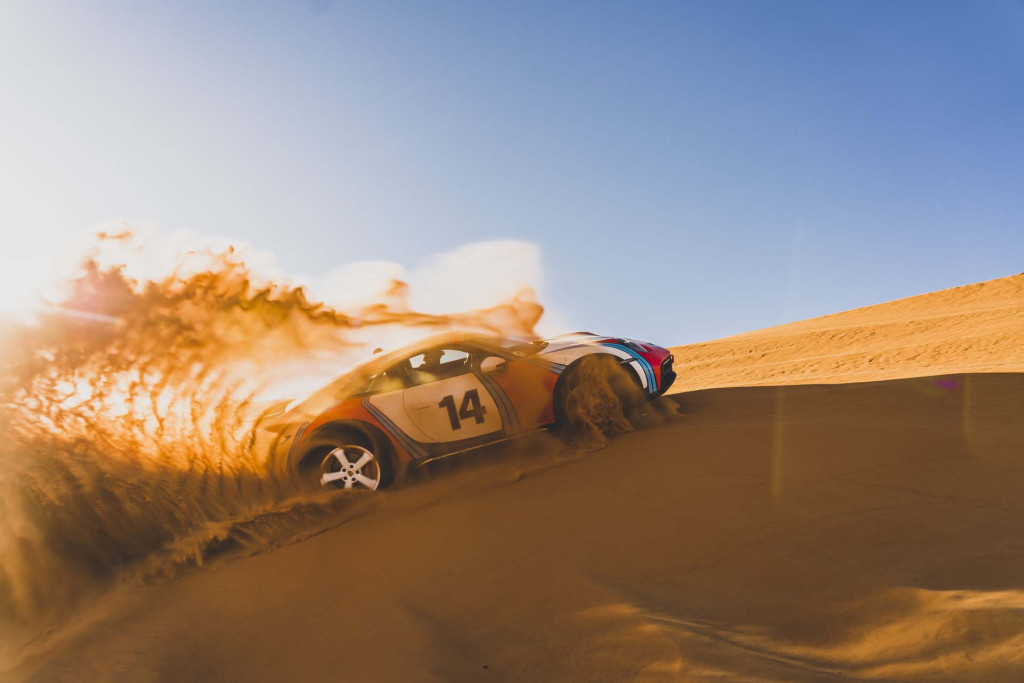
2023 Porsche 911 Dakar
In its higher setting, the 911 Dakar boasts approach, departure, and breakover angles of 16.1, 18.2, and 19.0 degrees, respectively. No, this doesn’t mean the Porsche can hang with Jeep Wranglers and Ford Broncos, but that’s hardly the point. Instead, it gives the 911 Dakar the ability to drive over rocks and sand with ease, and it can climb relatively steep inclines without producing any expensive-sounding scrapes at the base of the hill or when cresting it.
Despite all the additional equipment, the 911 Dakar only weighs 16 pounds more than an equivalent Carrera 4 GTS, at 3,552 pounds in total. Not having rear seats greatly contributes to this diet, but Porsche also fits the 911 Dakar with a carbon-fiber hood, roof, and rear spoiler. In fact, the hood is borrowed from the 911 GT3, hideous nostrils and all.
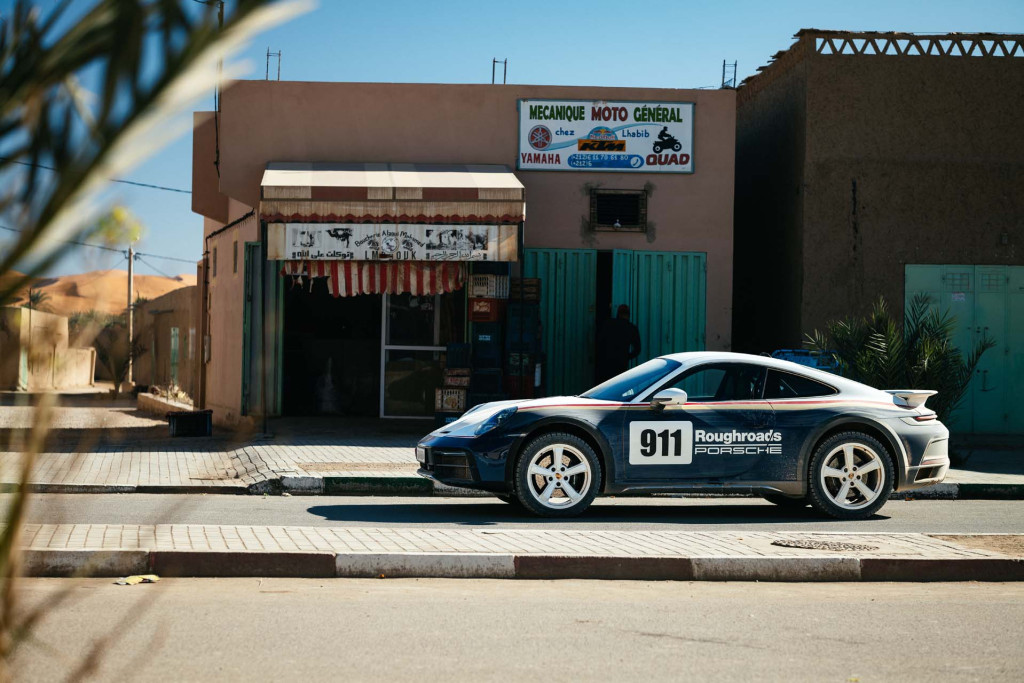
2023 Porsche 911 Dakar
The Dakar’s overall design is certainly polarizing, and I really think how attractive it is depends on how it’s ordered. The various throwback livery options look cool, and you have to admit, all done up in a Martini paint job, this thing looks totally at home bombing through the warm Sahara Desert sand. On the other hand, I really hate that the imitation Rothmans get-up says “Roughroads,” and to be honest, I’d probably skip the Rally Design Package altogether and stick with a solid-color body. Don’t forget, Porsche’s rainbow of paint-to-sample hues can be applied to the 911 Dakar. Be sure to check out the Techquipment catalog, too, for roof baskets, tents, and other accessories that’ll deplete every last dollar in your savings account.
Mounted atop the rear axle, the Dakar’s 3.0-liter twin-turbo flat-6 engine carries over unchanged from the Carrera 4 GTS, producing 473 hp and 420 lb-ft of torque. With a standard 8-speed dual-clutch automatic transmission and all-wheel drive, Porsche says the 911 Dakar will launch to 60 mph in 3.2 seconds, which is the same time as a rear-wheel-drive Carrera GTS. In other words, it’s damn fast.
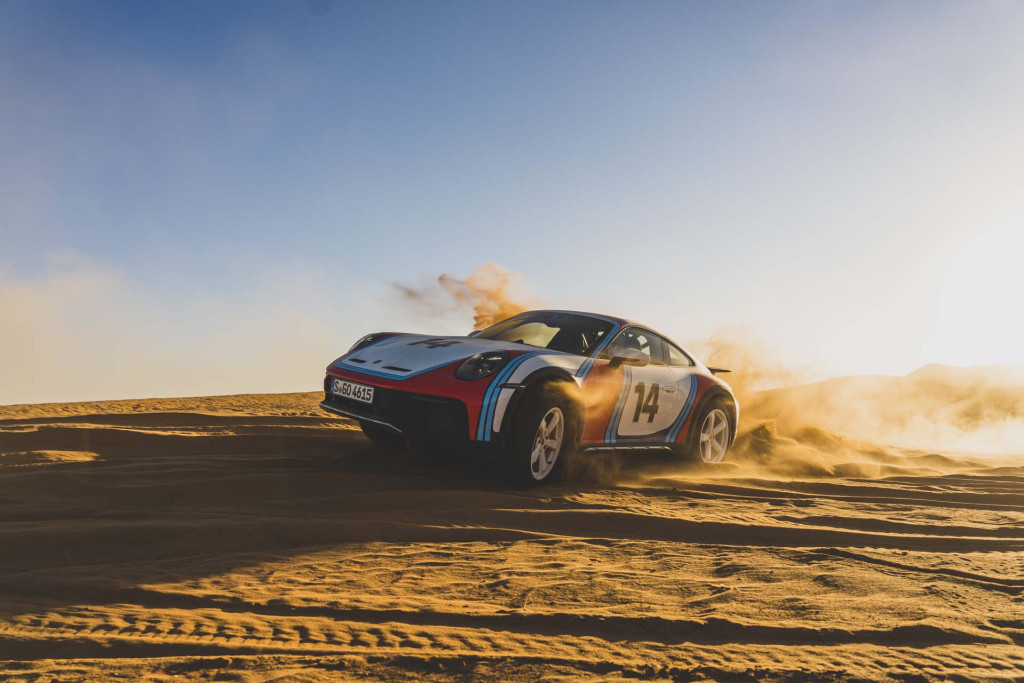
2023 Porsche 911 Dakar
Should you smash the throttle on dirt or gravel—and trust me, you should—be sure to use the new Rallye Launch Control function, which allows for 20% more wheelspin than normal. This genuinely makes the 911 Dakar easier to control when slamming it off the line on rough surfaces. Plus, it looks cool in action. Really, really cool.
The 911 Dakar uses a variable all-wheel-drive system with torque split between the front and rear axles that changes depending on the selected drive mode and amount of traction, among other factors. Rallye mode gives the AWD programming a stronger rear bias, so you’ll want to use this when shimmying around on the gravel. Completely disable the traction control by holding down the PSM toggle on the dashboard and the Dakar will let you drift to your heart’s content, the strong compound of the Pirelli Scorpion All-Terrain Plus tires ensuring you won’t blow the rubber to smithereens as you slide over rocky roads.
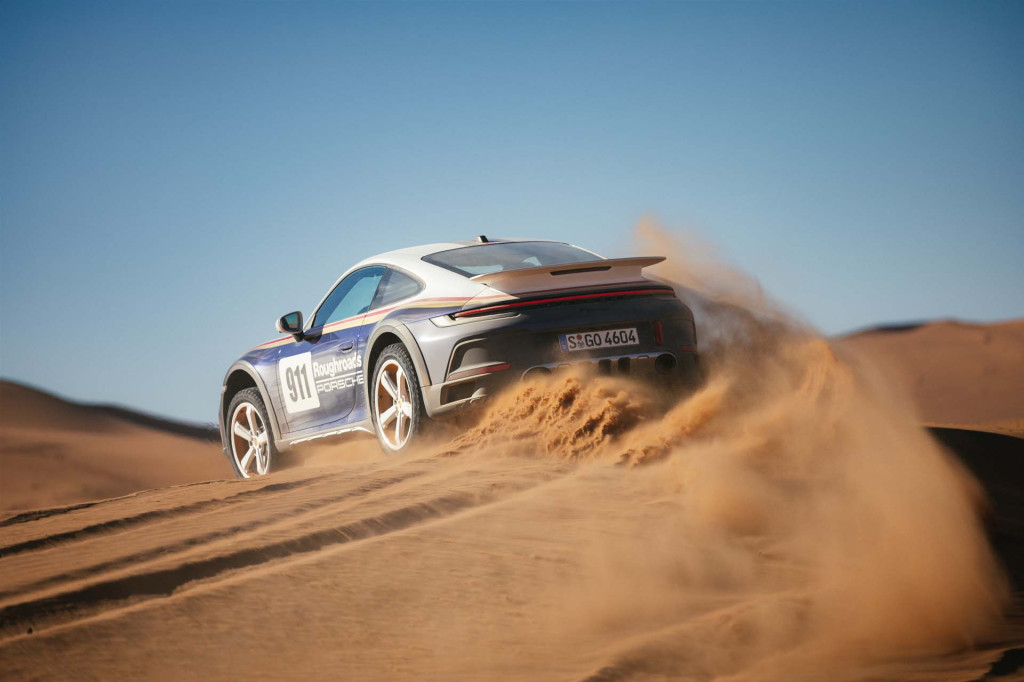
2023 Porsche 911 Dakar
Offroad mode is where things really get interesting, since it locks the 911 Dakar into an even 50/50 front/rear torque distribution. This gives the coupe the prowess it needs to keep going strong through soft sand. Steadily plant your foot on the throttle and you won’t have to worry about getting stuck. Because the Dakar’s standard torque-vectoring rear axle is still active in this mode, side-to-side power transfer keeps the 911’s rear end alive, meaning you can drift up the sides of dunes like a surfer catching a wave.
Anyone who buys a 911 Dakar and doesn’t take it off-roading is a real party pooper; this thing demands to get dirty. The strong power from the flat-6 engine keeps the Dakar going through sticky situations, and the Rallye and Offroad modes alter the transmission programming to ensure the engine stays humming in the heart of its rev range for longer. On the gravel, in the dunes—hell, even when bouncing over desert whoops—driving the Dakar never ceases to make me laugh. It’s just so thoroughly ridiculous. That’s the best kind of compliment, by the way.
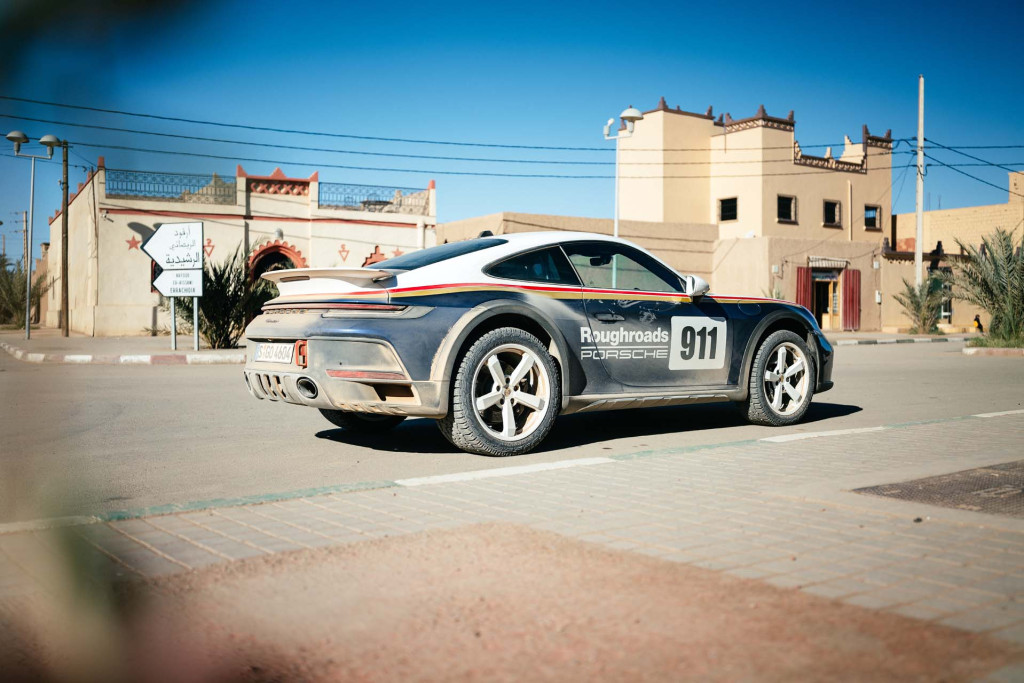
2023 Porsche 911 Dakar
On the paved roads between Porsche’s sandy Moroccan test grounds and the desert airport in Errachidia, the Dakar largely feels like any other 911, just louder thanks, tire noise and slightly more bouncy. But given the longer-travel suspension and rugged rubber, that’s to be expected. Body movements are slightly more exaggerated than you’d normally expect from a 911, but attributes like great steering and strong braking power are nevertheless intact.
The Carrera GTS’ active suspension (PASM), adjustable damper settings, torque vectoring, and rear-wheel steering have all been recalibrated to account for the Dakar’s new geometry, but the whole experience is still quintessentially 911. If on-road driving is your top priority, Porsche offers summer tires as a no-cost option, but they defeat the point of the Dakar as a whole. Please don’t be that person.
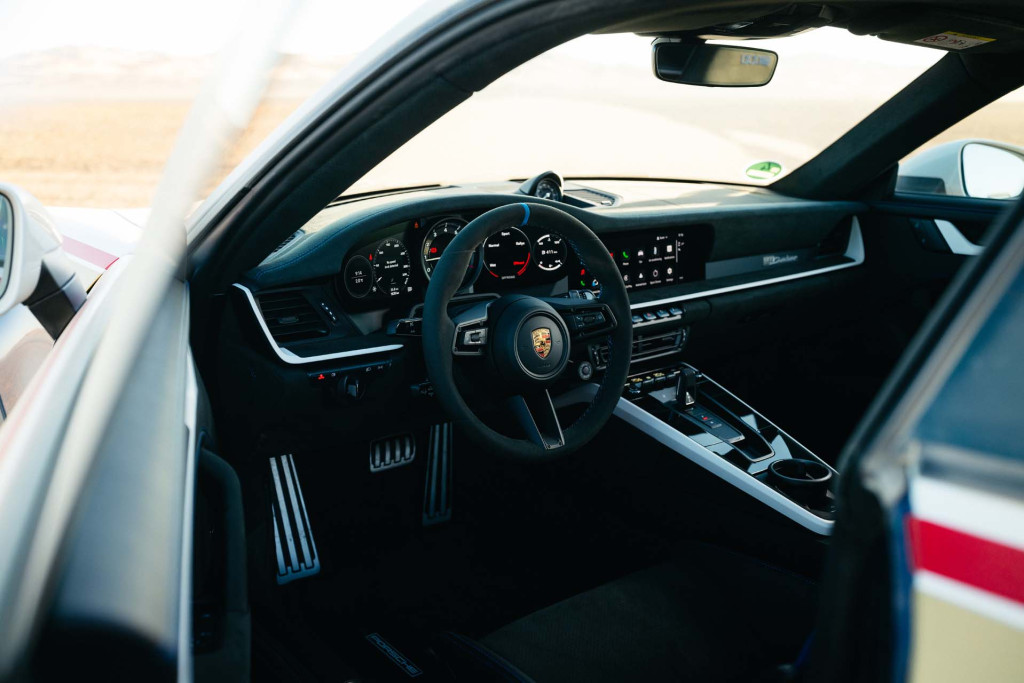
2023 Porsche 911 Dakar
The Dakar’s interior isn’t terribly different from other 911 models, save for a special badge on the passenger-side dash. The full carbon-fiber bucket seats Porsche offers in the GT3 are standard in the Dakar, though you can swap ’em out for 18-way adjustable chairs if you’d like something a little less supportive and a whole lot more comfortable. (It’s a $0 upgrade, too.) Multimedia duties are handled by Porsche’s latest Communication Management software, which now includes both Apple CarPlay and Android Auto compatibility—finally.
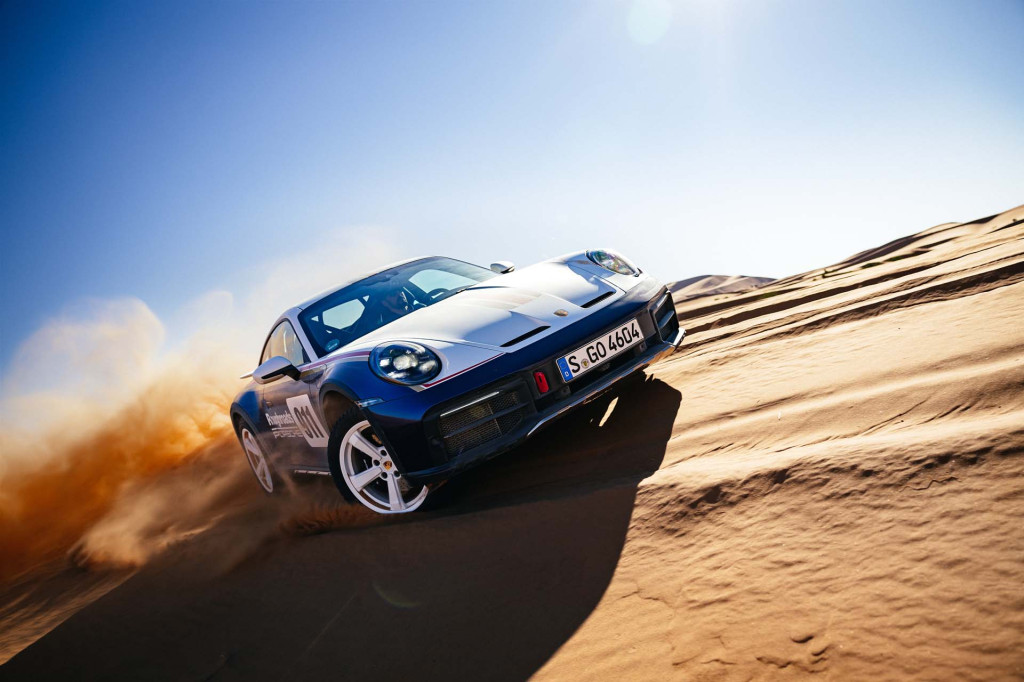
2023 Porsche 911 Dakar
Everything about the 911 Dakar package is super desirable, but its price tag makes it almost prohibitively out of reach for mere mortals. Despite being based on the $151,350 Carrera 4 GTS, the 911 Dakar starts at $223,450 including a $1,450 destination charge, putting it on the same rung as the GT3 RS in the 911 hierarchy. Then again, what other 911—or any sports car, for that matter—can off-road quite like this?
Globally, Porsche will offer 2,500 examples of the 911 Dakar, and it’s unclear exactly how many will come to the U.S. The initial run of cars will all be 2023 models, but because production is expected to span throughout the year, a few Dakars will technically carry over to the 2024 model year. The real question is: What happens after that?
I have no doubt Porsche will sell every single 911 Dakar it builds, and quickly, too. It’s a wild and rowdy thing that deserves all the attention it gets, and based on the success of “safari” 911s from aftermarket tuners like Ruf and Singer, demand likely won’t slow down. Perhaps a Dakar based on the 911 Turbo is the next logical step, especially since the Lamborghini Huracan Sterrato will soon be an off-road force as well. But no matter where Porsche decides to head from here, I just hope this Dakar isn’t the last.
—by Steven Ewing
Porsche paid for airfare and hotel accommodations for Motor Authority to bomb around the Morroccan desert and bring you this firsthand report.
